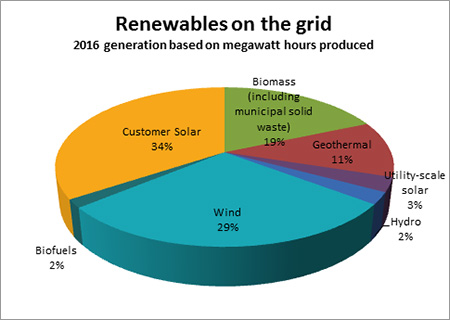
On Earth Day, Hawaiian Electric Companies note progress in reducing emissions, use of fossil fuel
News Release from HECO
HONOLULU, April 21, 2017 - To mark Earth Day 2017, the Hawaiian Electric Companies today noted their progress in replacing fossil fuels with renewable resources for power generation, reducing greenhouse gas emissions and leading efforts to switch to zero-emission electric vehicles.
Many of the companies' ambitious clean energy goals are described in the Power Supply Improvement Plan submitted to the Public Utilities Commission in December 2016. The plan calls for reducing operations that use fossil fuels, doubling private rooftop solar systems and aggressively seeking grid-scale renewable resources, among other goals.
Here are some highlights of the companies' progress toward a clean energy future:
Renewable energy
The Hawaiian Electric Companies reached a milestone in 2016, with 26 percent of the electricity used by customers coming from renewable resources - up from 23 percent the year before.
Hawaii Island customers' use of renewable electricity passed the halfway mark for the first time, with 54 percent of electricity coming from renewables, up from 49 percent in 2015. Maui County also reached a new high of 37 percent, up from 35 percent. On Oahu, 19 percent of electricity used by customers was from renewable resources, up from 17 percent the year before. The Power Supply Improvement Plan forecasts exceeding the state's renewable energy milestones of 30 percent in 2020, 40 percent in 2030, 70 percent in 2040 and 100 percent by 2045.
The companies' forecasts for future milestones include:
- 48 percent by the end of 2020;
- 72 percent by the end of 2030;
- 100 percent by the end of 2040, five years ahead of the 2045 deadline
Oil consumption down 21%
Renewable goals exist to increase self-sufficiency by relying on local resources like sun, wind, geothermal, local crops and waste. The companies' ultimate goals are to reduce dependence on imported oil and climate-altering greenhouse gas (GHG) emissions, especially carbon dioxide.
- From 2008 to 2016, Hawaiian Electric's use of oil in generators on Oahu fell to 6 million barrels from 7.8 million barrels. For all three Hawaiian Electric Companies, oil use fell to 8.5 million barrels from 10.7 million barrels, a 21 percent decrease.
- The Hawaiian Electric Companies' goal is to reduce GHG emissions to the 2010 level by 2020. In fact, it's anticipated the companies will do better, reducing the 2020 level to 16 percent below the 2010 level. That would cut emissions by 865,000 tons per year. That is equivalent to any one of the following:
- 1.8 million barrels of fuel per year
- Emissions from 166,000 passenger car in a year
- 1.9 million miles driven by passenger cars
- Energy consumed per year by 116,000 homes
Electric vehicle use accelerates
The number of registered plug-in electric vehicles (EV) has broken the 5,000 mark, a promising milestone that makes Hawaii second in the nation after California in EVs per capita. Hawaiian Electric has helped form Drive Electric Hawaii to accelerate adoption of electric vehicles through coordinated efforts and make it easier to expand vehicle-charging infrastructure in a way that brings more renewable energy onto the electric grid.
Drive Electric Hawaii partners include the Blue Planet Foundation; Hawaii State Department of Transportation (HDOT); Hawaii State Department of Business, Economic Development and Tourism; Hawaii State Division of Consumer Advocacy; the Hawaiian Electric Companies (including Maui Electric and Hawaii Electric Light); Kauai Island Utility Cooperative; Ulupono Initiative; and the Rocky Mountain Institute. Hawaiian Electric Companies' specific role is installing fast chargers to reduce drivers' "range anxiety."
A dozen fast chargers are available at shopping centers, visitor attractions and on utility property across the five islands the companies serve. More are coming. Transactions at our companies' fast chargers shot up in March as EVs on the road increased and drivers became more aware of the growing number of fast chargers.
For more about our environmental progress, visit: http://www.hawaiianelectric.com/about-us/our-commitment.